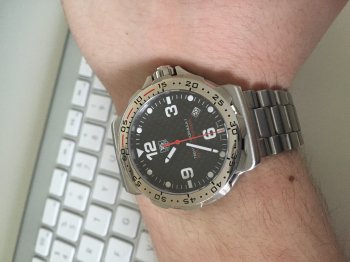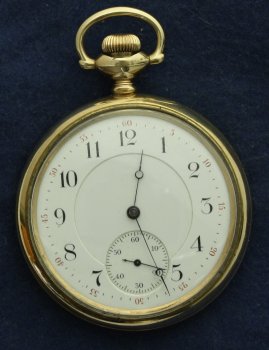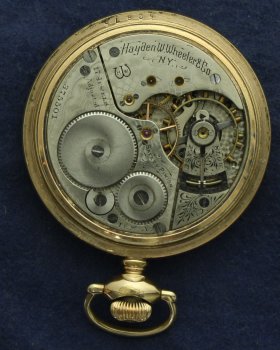Well, I, too am 'loving these posts' and the accompanying pictures.
They are interesting, full of fascinating new information, a bit of history, some lore, and informed by a genuine and wonderful enthusiasm for the topic and a generous joy in sharing this stuff with us. Thanks a lot.
Do you ever actually wear, or use any of these genuinely old watches as time-keepers? If I had such a thing, I would most certainly try to find a way to use it, occasionally.
Beautiful and functional objects should be used for whatever it is that they were designed to do, rather than gathering dust in a cupboard, or hiding away in a locked bank vault.
I have some beautiful heavy exceptionally well made crystal wine glasses that my parents had, and an uncle had, and I use them daily; if one gets broken, that is life; I derive great pleasure from them, rather than simply using them on one day of the year - say, Christmas Day, and living in fear of an accidental breakage instead of enjoying your glass of wine. Likewise, I have a set of antique sherry and port glasses - well over a century old - and I use them, too.
Anyway, reading your post, I found myself thinking about that date, 1860, which you mentioned at least twice. That, of course, is the year that Abraham Lincoln stood for election for the office of President, and won, beating a split Democrat ticket. Extraordinary to think of the times your watches have marked with their exquisite internal mechanisms. They are beautiful, and please keep posting about them.
Thank you for your nice comments.
As for wearing watches-I actually do with a lot of regularity. I wore one nearly daily for about 7 years. As a chemist, a pocket watch actually makes a lot o sense as it's safe from solvent splashes on the crystal and other things.
I have been wearing my Rolex pretty much daily lately, but on days where I know I'm going to be doing bench work I generally do wear a pocket watch.
Pretty much nothing is off limits for me to wear-about the only thing I don't wear are really crisp, high condition gold and silver cases.
Your question about my "1860" references actually requires a fairly long and involved back story.
At one time, it was fairly common for American manufacturers to name a new model of something after the year in which it was introduced. You see it, for example, in gun makers-you will often hear folks talk about 1873 and 1892 model Winchesters, or 1873 and 1911 model Colts.
Waltham was no exception, except that the model number sequence gets a bit convoluted and all the more interesting of a story to tell

The Warren Manufacturing Company was founded around 1850 in Roxbury, MA by three individuals-Edward Howard, Aaron Dennison, and an individual by the name of Davis. Davis was a financial backer, while Howard was a watchmaking genius. Dennison was an Engish-born watchmaker who handled a lot of the day-to-day operation o the company.
The first 17 watches produced were a dual barrel 8 day design that was not commercially successful. These were signed "Howard, Davis, and Dennison." One of these is in the Smithsonian, one was in Henry Ford's private collection(and is now in the Ford museum) and the remainder are still in private collections. One actually remained in the Waltham archives until 1988.
After these initial 17 watches, the company switched over to a more conventional 18 size full plate 30 hour design. It is thought that the first 82 of these were signed "Warren", although no example higher than serial number 44 is known. There are five examples of Warrens known-#18, #29, #31, #36, and #44. These are fascinating watches-I've personally handled #31, which is probably the second best example known after #18. After this, the next roughly 900 watches were signed Samuel Curtis. After this, the company moved to the banks of the Charles River in Waltham, and the next 4000 watches were signed Dennison, Howard, and Davis. After this, Howard left to found the E. Howard watch company in Boston.
In the mid to late 1850s, there was a push toward manufacturing higher grade watches in American. This was Howard's push in leaving. Waltham's own response was an 18 size, 3/4 plate watch in 1859. Around 1858, several engineers-namely Woerd and Fogg-defected from Waltham to found the Nashua Watch Company in Nashua, NH. The company designed a couple of different watches, namely a 20 size, 3/4 plate watch and a smaller companion 16 size watch. I think they finished about a dozen 20 size watches, some with 15j and some with 19j(I have 6 in my notes, although I know of a few others hidden in collections). At this point, the Nashua Watch Company ran out of money and were "rescued" by the American Watch Company at Waltham. Nashua was re-absorbed but maintained as their own separate department. The remaining Nashua 20 size material was finished at Waltham with 19j(these watches have a number of identifying characteristics and are very desireable) and signed "American Watch Company." Waltham also introduced the Nashua-designed 16 size movement. The 20 size and 16 size continued in production in two grades-the 19j "American Watch Company" grade and the 15j "Appleton, Tracy & Co" grade-AT&Co was a name the company briefly used around 1860. The Nashua department was responsible for several further very successful designs at Waltham.
At this point, the factory had been content to refer to watches by their size and configuration-i.e. 18 size full plate, 18 size 3/4 plate, etc. A new 18 size full plate model was introduced in 1870, however, and things began to get complicated. So, at that point, the company retroactively assigned model designations. The new 18 size model was called the 1870 model. The original 18 size full plate model(which continued in production well past the new 1870 model) was called the 1857 model. This was related-I believe-to when the company was called the Appleton, Tracy &Co, although the original design dated back to about 1851. The 18 size 3/4 plate model was the 1859 model. Where things really get odd, however, is with the Nashua derived models. The 16 size 3/4 plate Nashua-derived model was given the designation of the 1860 model, while the 20 size was called the 1862 model. 1860 was the year in which the American Watch Company reacquired Nashua, although the initial products finished were 20 size models and the 16 size came a bit later.
In any case, that's the model designation story. Of course, the model designation actually has no correlation to when the watch was made(the 1883 model, for example, was made well into the late 1920s).






























